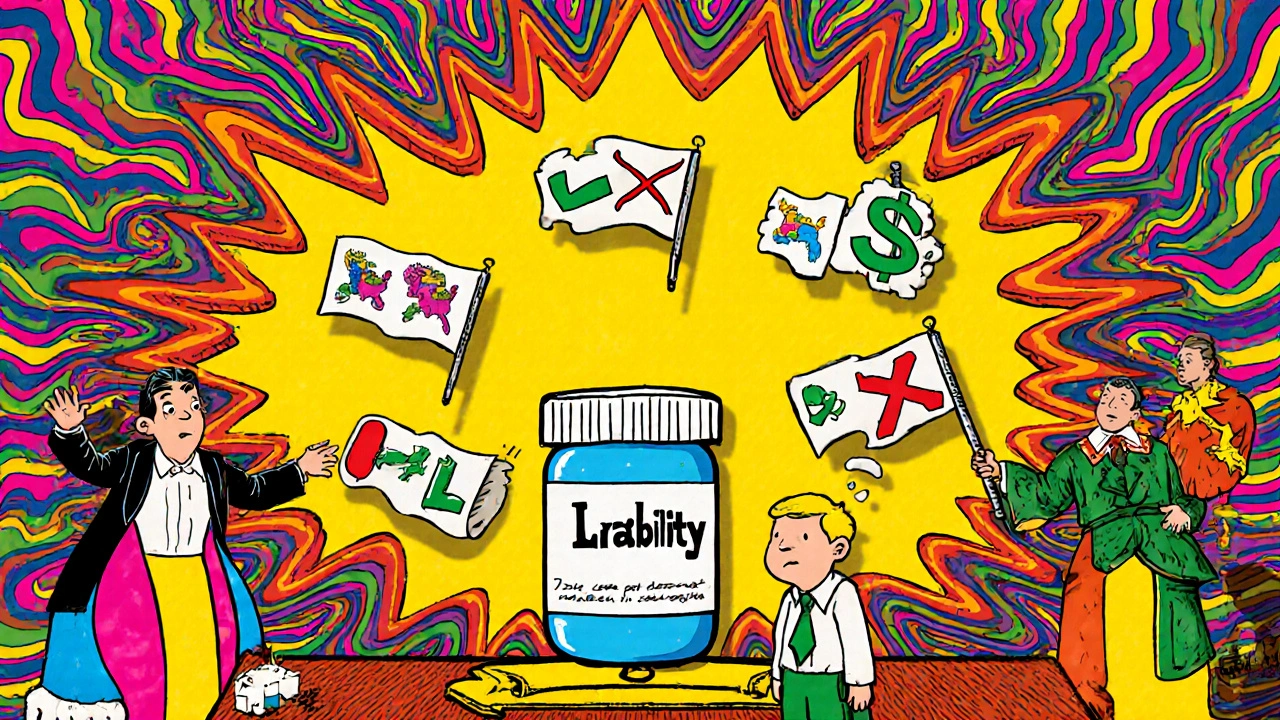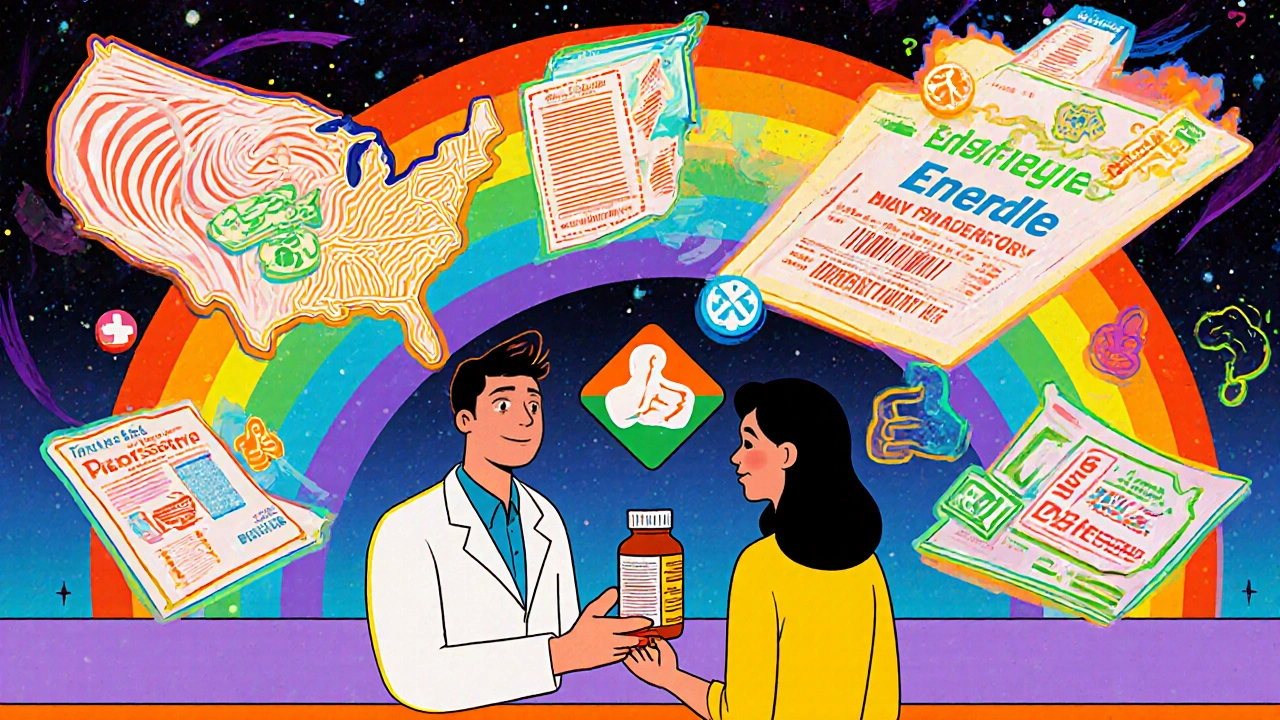When you pick up a prescription, you might not realize that the pill in your hand could be a different brand than what your doctor wrote on the script. That’s not a mistake-it’s generic substitution, and it’s governed by laws that vary wildly from state to state. In some places, pharmacists are required to swap brand-name drugs for cheaper generics. In others, they can’t do it unless you give permission. And in a few, they’re not even allowed to substitute certain drugs at all-even if the FDA says they’re safe to switch.
These rules exist to save money. Generic drugs cost, on average, 80% less than their brand-name equivalents. The FDA says they’re just as effective and safe. But the system isn’t uniform. With 51 different sets of rules (50 states plus Washington, D.C.), pharmacists are stuck playing a guessing game every time a prescription comes in. And patients? They often don’t know what’s happening until they get the bill-or worse, until their medication doesn’t work the same way.
What Exactly Is Generic Substitution?
Generic substitution means a pharmacist replaces a brand-name drug with a generic version that has the same active ingredient, strength, dosage form, and route of administration. The FDA approves these generics using strict standards, and they’re listed in the Orange Book-the federal database that rates drugs for therapeutic equivalence.
But here’s the catch: just because two drugs are chemically identical doesn’t mean they’re always interchangeable in practice. For drugs with a narrow therapeutic index-like warfarin, levothyroxine, or certain epilepsy meds-tiny differences in absorption can cause serious side effects. That’s why some states block substitution for these drugs entirely.
Still, for most medications, generics are a safe, cost-saving option. The problem isn’t science-it’s law. And the laws are a mess.
Mandatory vs. Permissive: The Two Main Types of Laws
States fall into two big categories: those that require substitution and those that only allow it.
Seventeen states-like California, New York, Texas, and Florida-have mandatory substitution laws. That means if a generic is available and the prescription doesn’t say "dispense as written," the pharmacist must switch it. These states have seen generic use rates jump 8-12 percentage points higher than states without mandatory rules. That translates to $50-$150 saved per prescription, on average.
The other 33 states and D.C. use permissive laws. Here, substitution is optional. The pharmacist can swap the drug, but only if they choose to. Some of these states add extra layers: Alaska, Delaware, Maine, and New Hampshire require pharmacies to post signs telling patients substitution is possible. But without a mandate, many pharmacists don’t bother-especially if they’re worried about liability or patient complaints.
Consent Rules: Do You Have a Say?
Even in permissive states, you might not get a choice. Seven states-Connecticut, Hawaii, Maine, Maryland, New Hampshire, Vermont, and West Virginia-plus D.C., require explicit patient consent before a substitution can happen. That means the pharmacist has to ask you, face to face, and get a verbal or written yes.
In 31 states and D.C., consent isn’t needed-but you still have to be notified after the fact. That’s usually done with a sticker on the bottle or a slip of paper. But studies show nearly half of patients don’t notice these notices. One survey by the National Psoriasis Foundation found 42% of patients on biosimilars didn’t realize their drug had been switched.
Hawaii takes it further: for antiepileptic drugs, you need consent from both your doctor and yourself. That’s because even small changes in blood levels can trigger seizures. Kentucky does something similar-keeping a list of drugs that can’t be substituted, including digoxin and certain seizure meds.
Liability: Who Gets Sued If Something Goes Wrong?
Pharmacists are on the front lines. If a patient has a bad reaction after a substitution, they could be held responsible. But only 24 states offer clear legal protection for pharmacists who follow substitution rules. States like Alabama, Arizona, Illinois, Massachusetts, Missouri, Nebraska, New Mexico, Oregon, and Rhode Island don’t shield them from liability.
That’s not just a legal issue-it’s a practical one. In states without protection, pharmacists often refuse to substitute, even when it’s allowed. One pharmacist in a multi-state chain told a Reddit thread: “I avoid swapping anything in states where I could be sued. I’d rather lose a few bucks than risk my license.”
That hesitation adds up. A 2022 study in the American Journal of Managed Care found that in states with strict liability rules, generic use dropped by 12.7% compared to states with clearer protections.

Biologics and Biosimilars: A New Layer of Complexity
Biologics-drugs made from living cells, like Humira or Enbrel-are expensive. Biosimilars are their cheaper, nearly identical cousins. But swapping them is trickier than swapping a generic pill.
Forty-five states treat biosimilars differently than small-molecule generics. They require the FDA to label them as “interchangeable”-a higher bar than regular generics. And 48 states plus D.C. force pharmacists to notify the prescribing doctor within 2-7 days after switching.
Even worse, six states that require generic substitution for pills still make biosimilar substitution optional. So you could get a generic version of your blood pressure med without asking, but if your biologic is switched? You might never know.
As of 2023, biosimilars made up only 11.2% of biologic prescriptions. Experts blame the patchwork of state laws. If substitution rules were consistent, usage would climb.
What’s Changing in 2025?
Pressure is building to fix this mess. Twelve states introduced the “State Harmonization of Generic Substitution Act” in early 2023. It’s not law yet-but it’s gaining traction. The goal: standardize consent, notification, and liability rules across state lines.
The FDA also updated its Orange Book in 2022 to include new “interchangeability” ratings for complex generics. Eighteen states are currently reviewing their laws to match. Meanwhile, 27 states are actively considering reforms in 2024, with a focus on biosimilars and narrow therapeutic index drugs.
One thing’s clear: the system is outdated. Pharmacists waste 15-30 minutes a day just figuring out which rules apply. EHR systems like Epic have built state-specific rule engines to help-but they’re not foolproof.
What You Should Do
If you’re on a chronic medication-especially something like thyroid medicine, blood thinners, or epilepsy drugs-ask your pharmacist: “Is this the brand or the generic?” Don’t wait for the bottle to tell you. Write “dispense as written” on your prescription if you don’t want a swap.
Check your state’s pharmacy board website. Most have free, searchable guides to substitution laws. The National Association of Boards of Pharmacy also offers an interactive map that’s updated quarterly.
And if you get a different pill than last time, don’t assume it’s the same. Call your doctor or pharmacist. Ask if it’s a generic. Ask if it’s safe. Your health isn’t worth guessing.

How States Compare: Quick Reference
Here’s a snapshot of key differences across states:
| Category | Number of States | Examples | Key Detail |
|---|---|---|---|
| Mandatory Substitution | 19 | CA, NY, TX, FL | Pharmacist must substitute unless "DAW" is marked |
| Permissive Substitution | 31 + DC | PA, OH, GA, WA | Substitution allowed but not required |
| Require Patient Consent | 7 + DC | CT, HI, ME, MD, NH, VT, WV | Must get your verbal or written approval first |
| Require Post-Substitution Notice | 31 + DC | MI, NC, CO, IL | Notice on bottle or receipt after the fact |
| Prohibit Substitution for NTI Drugs | 12 | KY, HI, NJ, MA | Warfarin, levothyroxine, epilepsy drugs excluded |
| No Liability Protection | 24 | AL, AZ, IL, MA, MO, NE, NM, OR, RI | Pharmacists risk lawsuits if patient has adverse reaction |
Frequently Asked Questions
Can my pharmacist switch my brand-name drug without telling me?
In 31 states and Washington, D.C., pharmacists are required to notify you after the switch-usually with a sticker or receipt. But in 7 states plus D.C., they must get your permission before swapping. In the remaining states, they can substitute without notice or consent. Always check your prescription label and ask if you’re unsure.
Are generic drugs really as good as brand-name ones?
Yes-for most drugs, generics are just as safe and effective. The FDA requires them to have the same active ingredient, strength, dosage form, and absorption rate as the brand. But for drugs with a narrow therapeutic index-like warfarin or levothyroxine-even tiny differences can matter. That’s why some states restrict substitution for these.
Why do some states block substitution for epilepsy drugs?
Antiepileptic drugs have a narrow therapeutic index, meaning the difference between a therapeutic dose and a toxic one is very small. Even slight changes in how the body absorbs the drug can trigger seizures. States like Hawaii and Kentucky prohibit substitution for these unless both the doctor and patient agree.
What’s the difference between a generic and a biosimilar?
Generics are exact chemical copies of small-molecule drugs (like aspirin or metformin). Biosimilars are similar-but not identical-to complex biologic drugs (like Humira), which are made from living cells. Biosimilars require more testing to prove safety and are subject to stricter substitution rules. Only FDA-approved "interchangeable" biosimilars can be swapped without a doctor’s order.
How can I find out my state’s substitution rules?
Visit your state’s Board of Pharmacy website. Most have free downloadable guides. You can also use the National Association of Boards of Pharmacy’s interactive map, updated quarterly. The FDA’s Orange Book app also shows which drugs are rated as interchangeable.
What’s Next?
If you’re on a long-term medication, don’t wait for the pharmacy to inform you. Take control. Ask questions. Know your state’s rules. If you’re switching states, check the laws before your next refill. And if you’ve ever had a bad reaction after a drug swap-tell your doctor. Your experience could help push for change.
Generic substitution saves billions every year. But it only works if patients understand it-and if the rules don’t make pharmacists afraid to use it. The system isn’t broken. It’s just outdated. And it’s changing. Slowly. But it is changing.


Amie Wilde
November 13, 2025 AT 10:38Just got my levothyroxine switched last week. Didn't notice until my heart started racing. Never again. Always check the label.
Gary Hattis
November 15, 2025 AT 02:07As someone who's lived in 5 states, this is wild. In Texas they swap everything unless you say no. In New York, they ask you like you're signing a divorce papers. Meanwhile, my cousin in India just gets whatever's cheapest and shrugs. We need federal standards, not 51 different rulebooks.
Esperanza Decor
November 16, 2025 AT 02:06I work in pharmacy admin and let me tell you - the EHR systems are barely keeping up. We had a patient come in furious because her epilepsy med switched and her doctor didn't get notified. Turns out the state law changed in January and the software hadn't updated. It's not the pharmacists' fault - it's the system. We're all just trying not to get sued while saving people money.
And biosimilars? Forget it. The paperwork alone takes 20 minutes per script. No wonder they're barely used.
My boss says if Congress doesn't fix this by 2026, we're just going to stop dispensing anything complex. Not because we're lazy - because we're terrified.
Renee Ruth
November 16, 2025 AT 04:08Oh here we go. Another ‘awareness’ post. Meanwhile, my sister had a seizure because her pharmacy switched her carbamazepine without telling her. And now she’s suing everyone. The system is a joke. The FDA doesn’t even know what’s happening. Pharmacists are just scared robots following broken rules. And you? You’re just another person reading this thinking ‘I’ll ask next time.’ Spoiler: you won’t.
Samantha Wade
November 16, 2025 AT 20:08This is an exceptionally well-researched and necessary overview. The disparity in state regulations not only endangers public health but also creates significant administrative inefficiencies within the healthcare system. The lack of liability protection for pharmacists in 24 states is particularly concerning - it incentivizes inaction, which directly undermines cost-saving objectives. A national framework, modeled after the FDA’s Orange Book standards, is not merely advisable - it is an ethical imperative.
I urge all readers to contact their state representatives and demand legislative reform. Your health is not a patchwork experiment.
Elizabeth Buján
November 18, 2025 AT 19:32It's funny how we trust generics for everything - batteries, toilet paper, even phone chargers - but when it comes to our bodies, suddenly we're scared of a different pill shape. I used to be paranoid too, until I learned that the FDA tests generics harder than most brands. Still... I get it. When you're on warfarin, you don't want to gamble. Maybe we need a color-coded system on bottles - green for safe swap, red for don't touch. Something you can’t miss.
Also - why do we still use paper stickers? We have QR codes. Scan it, get a video from your pharmacist explaining the switch. Simple. Human. Effective.
Andrew Forthmuller
November 20, 2025 AT 10:40vanessa k
November 21, 2025 AT 08:08My dad’s on digoxin. He didn’t know his med got swapped until his finger turned blue. We had to rush him to the ER. I don’t care what the law says - if you’re switching my family’s life-saving drug, you better damn well call us first. No stickers. No fine print. A phone call. Or don’t swap at all.
manish kumar
November 23, 2025 AT 01:53In India, we don’t have this problem because we don’t have brand-name drugs to begin with. Almost all medicines are generics, and the government regulates them tightly. But here in the US, it’s like a corporate game where the brand names pay pharmacists to not switch, and the patients pay the price. I’ve seen patients pay $300 for a brand-name insulin while the generic costs $20 - and they don’t even know they’re being overcharged because the system is designed to confuse them. The real villain isn’t the pharmacist - it’s the pharmaceutical lobby that spends billions to keep the status quo. If we had universal healthcare with centralized drug purchasing, this wouldn’t be an issue. But we don’t. So we’re stuck playing Russian roulette with our prescriptions.
And don’t get me started on biosimilars. They’re cheaper, safer, and just as effective - but the companies that make Humira are spending millions to lobby states to make substitution harder. It’s not science holding us back. It’s money.
People need to stop blaming pharmacists. They’re the only ones trying to help you while the whole system is rigged against you.
Next time you get a prescription, ask your pharmacist: ‘Is this generic? If not, why not?’ If they hesitate - that’s your red flag.
Nicole M
November 25, 2025 AT 01:53So if I’m in California and my doctor writes ‘dispense as written’ but I move to Texas, does the prescription still block substitution? Or does Texas law override it?
Arpita Shukla
November 25, 2025 AT 07:20You people are overcomplicating this. The FDA says generics are safe. End of story. If you’re having side effects, it’s probably because you’re not taking it right, or your body is just weird. Stop blaming the system. Also, biosimilars aren’t ‘nearly identical’ - they’re 90% the same, and that’s enough. The rest is marketing fear. And yes, I’ve read the Orange Book. You haven’t.
Benjamin Stöffler
November 26, 2025 AT 16:44Let’s be honest: the entire generic substitution framework is a philosophical paradox wrapped in bureaucratic absurdity. On one hand, we demand cost-efficiency and accessibility; on the other, we demand absolute biological certainty - a standard unattainable even in controlled laboratory conditions. The FDA’s ‘therapeutic equivalence’ rating is, at its core, a statistical approximation - not a metaphysical guarantee. And yet, we treat it as gospel. We’ve turned pharmacology into a legal sport, where the rules change with every state line, and the players - the pharmacists - are forced to navigate a labyrinth designed by lobbyists, not scientists. The real tragedy? The patients who die or suffer because the system prioritizes liability over logic. We don’t need more laws. We need a redefinition of trust - in science, in professionals, and in each other.
Alex Ramos
November 28, 2025 AT 07:03Biggest tip I’ve learned from working in 3 states: Always write 'DAW 1' on your prescription if you don't want it switched. Even in mandatory states, that overrides everything. And if you're on anything with a narrow therapeutic index - thyroid, seizure, blood thinners - keep the original bottle as proof. I've seen people get switched to a different generic and then blamed for 'non-compliance' when their levels went haywire. It's not your fault. It's the system.
Also - if your pharmacist doesn't offer to explain the switch, ask them. Seriously. They're trained to do it. If they don't, find a new one. Your life isn't a guessing game.
And for anyone worried about biosimilars: if it's FDA-approved as 'interchangeable,' it's safe. The science is solid. The politics? Not so much. 😊